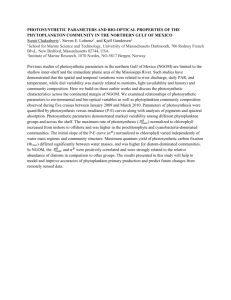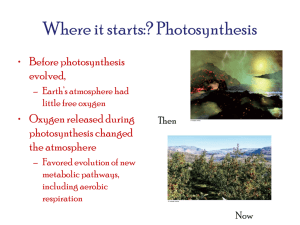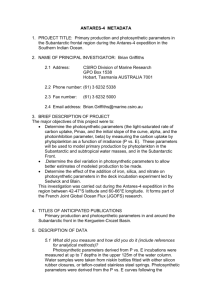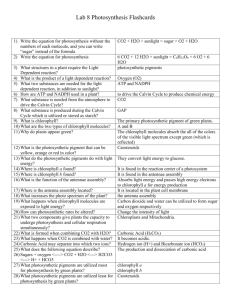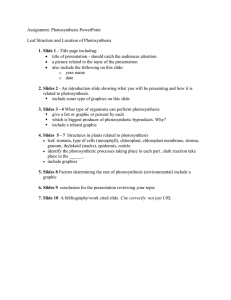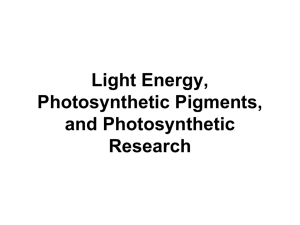S-PM2 Bacteriophage as a Remedy for Photoinhibition in Agricultural Crops
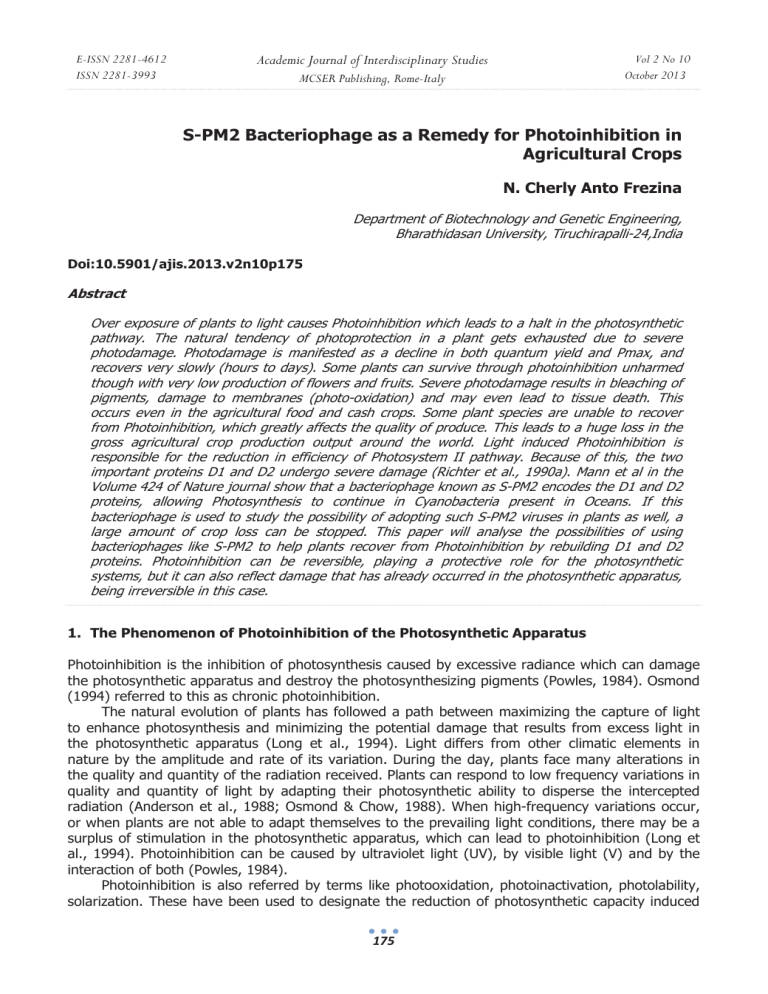
E-ISSN 2281-4612
ISSN 2281-3993
Academic Journal of Interdisciplinary Studies
MCSER Publishing, Rome-Italy
Vol 2 No 10
October 2013
S-PM2 Bacteriophage as a Remedy for Photoinhibition in
Agricultural Crops
N. Cherly Anto Frezina
Department of Biotechnology and Genetic Engineering,
Bharathidasan University, Tiruchirapalli-24,India
Doi:10.5901/ajis.2013.v2n10p175
Abstract
Over exposure of plants to light causes Photoinhibition which leads to a halt in the photosynthetic pathway. The natural tendency of photoprotection in a plant gets exhausted due to severe photodamage. Photodamage is manifested as a decline in both quantum yield and Pmax, and recovers very slowly (hours to days). Some plants can survive through photoinhibition unharmed though with very low production of flowers and fruits. Severe photodamage results in bleaching of pigments, damage to membranes (photo-oxidation) and may even lead to tissue death. This occurs even in the agricultural food and cash crops. Some plant species are unable to recover from Photoinhibition, which greatly affects the quality of produce. This leads to a huge loss in the gross agricultural crop production output around the world. Light induced Photoinhibition is responsible for the reduction in efficiency of Photosystem II pathway. Because of this, the two important proteins D1 and D2 undergo severe damage (Richter et al., 1990a). Mann et al in the
Volume 424 of Nature journal show that a bacteriophage known as S-PM2 encodes the D1 and D2 proteins, allowing Photosynthesis to continue in Cyanobacteria present in Oceans. If this bacteriophage is used to study the possibility of adopting such S-PM2 viruses in plants as well, a large amount of crop loss can be stopped. This paper will analyse the possibilities of using bacteriophages like S-PM2 to help plants recover from Photoinhibition by rebuilding D1 and D2 proteins. Photoinhibition can be reversible, playing a protective role for the photosynthetic systems, but it can also reflect damage that has already occurred in the photosynthetic apparatus, being irreversible in this case.
1. The Phenomenon of Photoinhibition of the Photosynthetic Apparatus
Photoinhibition is the inhibition of photosynthesis caused by excessive radiance which can damage the photosynthetic apparatus and destroy the photosynthesizing pigments (Powles, 1984). Osmond
(1994) referred to this as chronic photoinhibition.
The natural evolution of plants has followed a path between maximizing the capture of light to enhance photosynthesis and minimizing the potential damage that results from excess light in the photosynthetic apparatus (Long et al., 1994). Light differs from other climatic elements in nature by the amplitude and rate of its variation. During the day, plants face many alterations in the quality and quantity of the radiation received. Plants can respond to low frequency variations in quality and quantity of light by adapting their photosynthetic ability to disperse the intercepted radiation (Anderson et al., 1988; Osmond & Chow, 1988). When high-frequency variations occur, or when plants are not able to adapt themselves to the prevailing light conditions, there may be a surplus of stimulation in the photosynthetic apparatus, which can lead to photoinhibition (Long et al., 1994). Photoinhibition can be caused by ultraviolet light (UV), by visible light (V) and by the interaction of both (Powles, 1984).
Photoinhibition is also referred by terms like photooxidation, photoinactivation, photolability, solarization. These have been used to designate the reduction of photosynthetic capacity induced
175
E-ISSN 2281-4612
ISSN 2281-3993
Academic Journal of Interdisciplinary Studies
MCSER Publishing, Rome-Italy
Vol 2 No 10
October 2013 by the exposure of the plant or its leaves to an excess of visible light and photodynamic reactions
(Powles, 1984; Krause, 1988). The term photoinhibition has also been used as a synonym for the damage caused to photosystem II (PS II), but this damage to PS II is considered photoinhibition when there is a decrease in the whole photosynthetic capacity and not in just one component of the photosynthetic apparatus (Long et al., 1994).
In practice, the consequences of photoinhibition are:
1.
reduced maximum quantum efficiency for CO
2
absorption and release of O photochemical activity of PS II (Fv/Fm, ratio of fluorescence of chlorophyll
2
2.
decreased convexity in the response curve of photosynthesis to light; reduced
a
;
);
3.
and decreased maximum photosynthetic rate (PSmax) (Boese & Huner, 1992; Long et al.,
1994).
The decreases of Fv/Fm were noticed preceding reduction in PS without causing any alteration in PS max max
; actually, they can occur
(Long et al., 1994). A prolonged exposure of plants to excessive radiation may result in the photodestruction of the photosynthetic pigments, since the discoloration (bleaching) of these pigments depends on oxygen and light; this phenomenon is normally called photooxidation, which can cause the death of the plant (Powles, 1984; Hendrey et al., 1987).
In most cases, photooxidation is a secondary phenomenon, occurring after a slow phase during which there is already a decrease of the photosynthetic activity dependent on light intensity and exposure time, but without any changes in the pigment pool (Powles, 1984; Long et al., 1994).
Therefore, photoinhibition of photosynthesis does not appear after the destruction of the pool of pigments; on the contrary, the bleaching of pigments occurs when a certain degree of photoinhibition has already occurred (Hendrey et al., 1987). As a rule, plants adapted to full sunlight are able to acclimate and grow in shady conditions, whereas shade-grown plants may not bear full sunlight (Smith, 1982).
When a sunlight plant grown under low radiance conditions is transferred to high radiance, there is an enhancement in the photosynthetic capacity as the plant adapts itself to the increase of irradiance. However, leaves from these plants may show photoinhibition, with a decline in photosynthetic activity and in the quantum yield, if this transfer is abrupt. In this case, mature leaves that at first suffered photoinhibition may suffer discoloration of the photosynthesizing pigments, leading to cellular death. Young leaves, developed after transfer to high irradiance, do not exhibit photoinhibition. Plants acclimated to low irradiance and exposed to high irradiance are more severely photoinhibited than are those primarily adapted to high irradiance (Long et al.,
1994). This difference shows that the photosynthetic capacity influences susceptibility to photoinhibition.
The light-harvesting complexes must have pigments of such shape and size that they can transfer energy to reaction centers efficiently. Thus, when the plant develops in shade, there is an increase in the ratio between antenna pigments and reaction centers (Anderson & Osmond, 1987;
Osmond & Chow, 1988; Horton & Ruban, 1992). The result of this adaptation is that photosynthesis saturates at low irradiances. As a consequence, under high irradiance, the absorption rate exceeds the rate that can be used for photosynthesis, predisposing the plant to damage induced by the excessive radiation (Horton & Ruban, 1992).
Under normal conditions, a considerable amount of photons is intercepted by the photosynthetic apparatus, funnel shaped to the reaction centers and transferred, via electron transport chain, to production of NADPH2 and ATP (Powles, 1984). According to the accepted electron transport scheme, there should be 8 mols of photons for a reduction of 2 mols of
NADPH+, which is linked to the synthesis of 2.66 mols of ATP. In C3 plants, 2 NADPH and 3 ATP are necessary to assimilate one CO2 in carbohydrate (Krause, 1988). The main drains of this chemical energy are the cycles of photosynthetic reduction of CO2 (PCR) and the photorespiratory carbon oxidation (PCO). In this way, a large fraction of intercepted photons is transferred to propel carbon metabolism. When this metabolism is lacking, the use of excitation energy is insignificant,
176
E-ISSN 2281-4612
ISSN 2281-3993
Academic Journal of Interdisciplinary Studies
MCSER Publishing, Rome-Italy
Vol 2 No 10
October 2013 even though radiation absorption remains constant; this can result in photoinhibition (Powles,
1984). Actually, photoinhibition also depends on the rate of light absorption through the leaf
(Anderson & Osmond, 1987).
2. The Mechanism of Photoinhibition
Since 1956, when Kok published his work (Long et al., 1994), it has been proposed that the primary site of damage of photoinhibition is the reaction center of PS II.
There are currently two hypotheses concerning the primary site of damage of photoinhibition of PS II: the first is related to the reaction center; and the latter, to protein D1. In the first hypothesis, according to Powles (1984), transportation of electrons through PS II is inhibited when photoinhibition is induced by a surplus of light or by illumination without the recycling of carbon.
Observation that the action spectrum for photoinhibition follows the action spectrum of photosynthesis, and that the initial symptom of photoinhibition is the decreased photochemical efficiency of PS II, supports the hypothesis that photoinhibition is a result of energy absorbed by photosynthetic pigments and funneled to the reaction center of PS II, modifying it (Havaux &
Davaud, 1994; Long et al., 1994). This modified reaction center captures radiant energy efficiently, but it converts this captured energy into heat (Krause, 1988). The second hypothesis says that the initial site of damage of photoinhibition is the D1 protein (Richter et al., 1990a).
Actually, research in the last 15 years has established the role of the D1 protein in the photoinhibition phenomenon. Hundal et al. (1990) verified inactivation and/or debasement of this protein of PS II associated with photoinhibition. Greer et al. (1986) and Leitsch et al.
(1994) confirmed the blockage in recovery from photoinhibition by chloramphenical, an inhibitor of the D1 protein synthesis. Closure of D1 with powerful oxidizing radicals can clarify the vulnerability of this protein (Richter et al., 1990b). Working with mutants of the D1 polypeptide of
Synechocystis,
Maenpaa et al. (1995) suggested that a modification in the structure of the D-de loop of D1 could affect the mechanism of recovery from photoinhibition. Ji and Jiao (2000) showed that PS II photochemical efficiency (Fv/Fm) decreased and that nonphotochemical quenching (qN) increased in rice leaves when synthesis of the D1 protein was inhibited. In DTT (Dithiothreitol)pretreated leaves, when xanthophyll cycle was inhibited, there was a decrease in qN and, consequently, more loss of the D1 protein (associated with a large decrease in Fv/Fm). They concluded that the turnover capacity for the D1 protein is an important physiological basis for tolerance of photoinhibition.
3. Action of S-PM2 Baceriophage
Bacteriophage S-PM2 infects several strains of the abundant and ecologically important marine cyanobacterium Synechococcus. A large lytic phage with an isometric icosahedral head, S-PM2 has a contractile tail and by this criterion is classified as a myovirus . The linear, circularly permuted,
196,280-bp double-stranded DNA genome of S-PM2 contains 37.8% G+C residues. It encodes 239 open reading frames (ORFs) and 25 tRNAs. Of these ORFs, 19 appear to encode proteins associated with the cell envelope, including a putative S-layer-associated protein. Twenty additional
S-PM2 ORFs have homologues in the genomes of their cyanobacterial hosts. There is a group I self-splicing intron within the gene encoding the D1 protein. A total of 40 ORFs, organized into discrete clusters, encode homologues of T4 proteins involved in virion morphogenesis, nucleotide metabolism, gene regulation, and DNA replication and repair.
The discovery that S-PM2 encoded the D1 and D2 proteins of photosystem II suggests that a component of the phage's replicative strategy is to maintain the structural and functional integrity of at least part of the photosynthetic apparatus in order to provide energy for phage replication.
This important discovery will have a great impact on the agricultural sector which looses a lot of produce every year owing to the photoinhibition.
177
E-ISSN 2281-4612
ISSN 2281-3993
Academic Journal of Interdisciplinary Studies
MCSER Publishing, Rome-Italy
Vol 2 No 10
October 2013
4. Future Directions in Research
Clearly much remains to be done to understand the complex interactions between the S-PM2 bacteriophage and the photoinhibitory regulation in the plants. The S-PM2-Cyanobacterial system provides us with an excellent experimental model system to accomplish such a task (Mann et al,
2000). Potentially the most exciting outcome of this future work will be the application of the phage’s job in larger plants, especially food and cash crops. Since many crops find it difficult to emerge from photoinhibition leading to a great drop in the crop produce amount. If this proves true, it means there will be a direct and potentially important role of phage in the agricultural revolution. Phages are both unbelievably abundant and unbelievably diverse in nature. These characteristics, coupled with their unusually promiscuous genetic exchange, may make phages the preferred testing ground for this kind of experimentation.
References
Clokie MRJ, Shan J, Bailey S, Jia Y, Krisch HM, West S & Mann NH (2006) Transcription of a
‘photosynthetic’ T4-type phage during infection of a marine cyanobacterium. EnvironMicrobiol 8:
827–835.
Kao CC, Green S, Stein B & Golden SS (2005) Diel Infection of a Cyanobacterium by a Contractile
Bacteriophage. Appl Environ Microbiol 71: 4276–4279.
Kawamura M, Mimuro M & Fujita Y (1979) Quantitative relationship between two reaction centers in the photosynthetic system of blue–green algae. Plant Cell Physiol 20: 697–705.
Melis A (1999) Photosystem-II damage and repair cycle in chloroplasts: what modulates the rate of photodamage in vivo? Trends Plant Sci 4: 130–135.
Six C, Thomas JC, Brahamsha B, Lemoine Y & Partensky F (2004) Photophysiology of the marine cyanobacterium Synechococcus sp. WH8102, a new model organism. Aquat Microb Ecol 35: 17–29.
Jinyu Shan, Ying Jia, Martha R.J. Clokie & Nicholas H. Mann(2008) Infection by the‘photosynthetic’phage
S-PM2 induces increased synthesis of phycoerythrin in Synechococcus sp.WH7803; FEMS
Microbiology Letters 283, Issue 2.
Mann, N.H., Clokie, M.R., Millard, A., Cook, A., Wilson, W.H., Wheatley, P.J.,Letarov, A., and Krisch, H.M.
(2005). The genome of S-PM2, a photosynthetic T4 type baceriophage hat infects marine
Synechococcus srains, J. Baceriol. 187(9), 3188-3200.
Christon J. Hurst (2011) Studies in Viral Ecology: Animal Host Systems-Vol 2; Wiley Blackwell publications.
Mann, N. H., A. Cook, A. Millard, S. Bailey, and M. Clokie. 2003. Marine ecosystems: bacterial photosynthesis genes in a virus. Nature 424:741.
Sharon I, Tzahor S, Williamson S, Shmoish M, Man-Aharonovich D, Rusch DB, Yooseph S, Zeidner G,
Golden SS, Mackey SR, Adir N, Weingart U, Horn D, Venter JC, Mandel-Gutfreund Y, Béjà O;
(2007)Viral photosynthetic reaction center genes and transcripts in the marine environment, ISME
J. 2007 Oct;1(6):492-501. Epub 2007 Aug 9.
Michael Richter, Wolfgang Rühle, Aloysius Wild; Studies on the mechanism of photosystem II photoinhibition I. A two-step degradation of D1-protein; Photosynthesis Research Volume 24, Issue
3, pp 229-235; ISSN 0166-8595.
178

